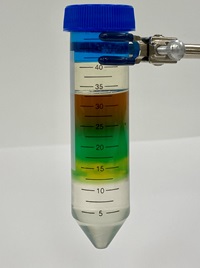![]()
Density is one of the fundamental scientific principles of life. It can describe any everyday object. Despite its significance, students often struggle to understand what it really is.
Density is a measurement of how much space or volume is packed in an object or substance.
 So, how does density impact every aspect of our lives? Density is the basis for gold mining, blood separation, strawberry DNA extraction and even layered towers (like the one you see here).
So, how does density impact every aspect of our lives? Density is the basis for gold mining, blood separation, strawberry DNA extraction and even layered towers (like the one you see here).
Students can demonstrate density by creating a liquid tower with layers of different substances like syrup, vegetable oil, water or dish soap. What causes the different layers to form? It’s the difference in the density of the substances. You can show students an example using corn syrup and rubbing alcohol. When put together, the corn syrup will sink to the bottom of a cylinder.
To apply this phenomenon to the real world, ask students to think about how density impacts our bodies. Think about the difference between muscles and fat. Muscle tissue needs to be denser to accommodate muscle fibers, while fat needs to be less dense to accomplish energy storage. Since there are different functions for fat and muscle, the cells have different densities suited for their particular jobs.
If your students are still confused about levels of density, try using the sink or float analogy. It might seem like large objects should sink while small ones should float. Challenge their misconceptions by using the example of a beach ball and a dime. The large beach ball floats in water because it is less dense than water, but the small coin sinks because it is denser than water.
Do you want a hands-on density lesson created by Sanford PROMISE? Click here to see the entire density lesson.